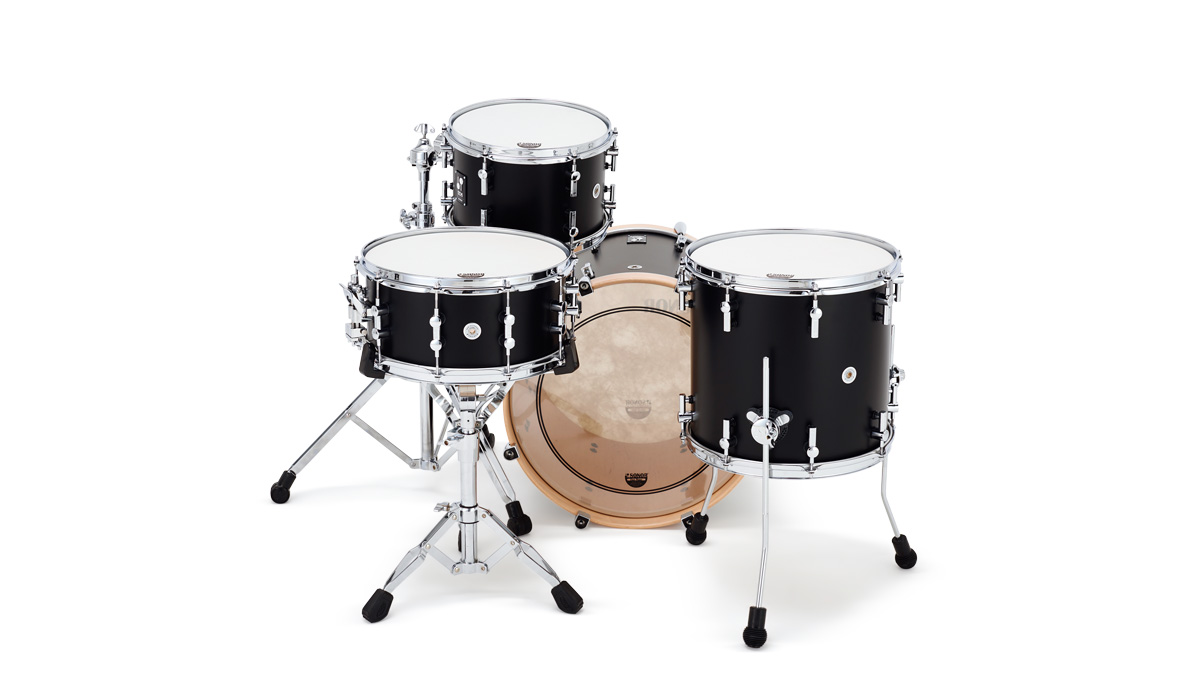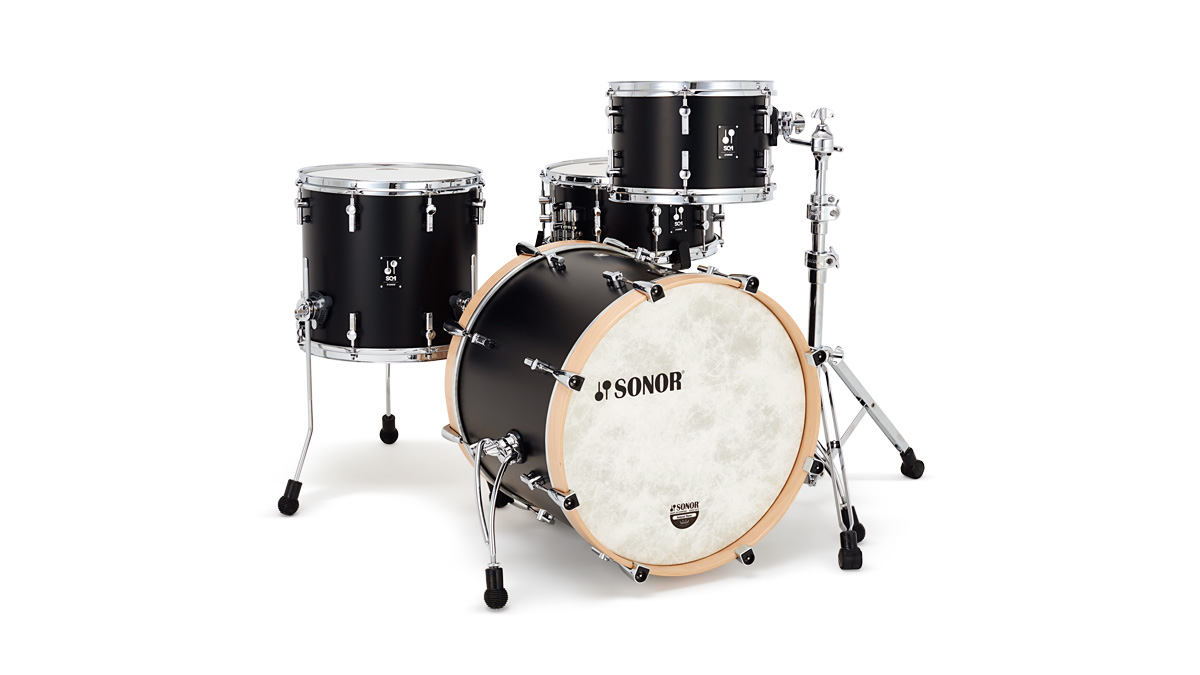MusicRadar Verdict
Fastidiously designed and built, with the new Sound Sustainer concept Sonor’s SQ1 points the way to a new era of more practical and unobtrusive tom mounting solutions.
Pros
- +
Incredible build.
- +
Forward-thinking hardware.
Cons
- -
Some minor quibbles with over-engineering of hardware.
MusicRadar's got your back
It’s always a thrill when Sonor sends us a German-made drum kit to review.
You know you’re going to find a beautifully crafted and finished state-of-the-art instrument. The SQ1 is no exception.
Benefitting from a host of range-topping SQ2 features, Sonor’s Product Manager Frank Boestfleisch reveals that, “The idea is based on our former Birch Infinite series. Our goal was to develop a ‘Made in Germany’ kit priced below our other current MIG series. So the Sonor hierarchy goes SQ2, ProLite, Vintage then SQ1.”
By restricting the available choices Sonor can offer a genuine German-made kit at a feasible price. But the big news is the game-changing Sound Sustainer tom mounts.
Build
There’s hardware, and there’s Sonor hardware. So let’s break with convention and start with those exciting new tom mounts (not a sentence you expect to read too often).
Along with just about every other company, Sonor has previously developed some form of post-RIMS resonance isolation mount. Sonor’s is called T.A.R. (Total Acoustic Resonance). The problem with isolation brackets is not that they don’t promote longer sustain - they generally do - but they obscure the toms and require massive supporting hardware.
But now Sonor has come up with enlarged rubber gaskets called Sound Sustainers. These have a “two-component connection (rubber to metal) that enables complete isolation of the metal mount and the wooden shell”.
Want all the hottest music and gear news, reviews, deals, features and more, direct to your inbox? Sign up here.
Unlike some other companies that peddle unsubstantiated twaddle, Sonor consults scientific institutes. From the 1980s Sonor has worked with the National Metrology Institute of Germany, developing its Advanced Projection System (APS), rubber insulators that prevent direct contact between wood and metal.
Most other companies also now throw on rubber gaskets to aid resonance. Sound Sustainers are an extension of this idea and have been developed in conjunction with the German automotive industry which uses vulcanisation (the hardening of rubber via sulphurisation) to isolate vibrating components, like engine mounts.
In Sonor’s case the Sound Sustainer is a somewhat bloated three-point mount rubber gasket gubbins that is still far less obtrusive than the previous T.A.R. mount.
By restricting the available choices, Sonor can offer a genuine German-made kit at a feasible price. But the big news is the game-changing Sound Sustainer tom mounts
As for the shells themselves, these are staple European birch. Frank says, “In the prototype phase we tested shell compositions like birch/beech or birch/poplar, but the result of our blindfold tests with different drummers was that pure birch shells work best.” So we have 10-ply, 10mm bass drums and 7-ply, 7mm toms and snare with 45 degree bearing edges.
Construction follows Sonor’s usual Cross Lamination Tension Free (CLTF) method and they are slightly more undersized than most shells to ease seating and tuning. Sonor calls this Optimum Shell Measurement (OSM). They are precisely round with carefully cut edges.
There are four monochrome options, all inspired by classic cars and motorbike colours. These are Cruiser Blue and Roadster Green, offset with Natural Walnut hoops; and Hot Rod Red or GT Black offset with Natural Beech hoops. Our kit is the latter and the black matte satin surfaces feel like polished marble. Inside, the birch is sealed with clear lacquer and the inner ply laid vertically, another Sonor trait that has been copied over the years.

Our kit is the smaller of three standard shell pack sizes, the 320, with 20"x16" kick, 12"x8" and 14"x13" toms, with a 14"x6½" matching snare drum. For alternatives and add-ons see the Spec box.
Back to hardware and the Dual Glide snare strainer is also something to see. Throw-offs have a long and, ahem, up-and-down history. You can still buy any number of snare drums that are let down by a naff strainer. Well, Sonor doesn’t do things by half and the Dual Glide - both throw-off and butt-end - is monumental. It somehow reminds us of lock gates on the Panama Canal, rendered in miniature and blinding chrome.
The ample, arched throw lever encircles two spring piston rods which in turn surround a calibrated tension knob. The two piston rods (on both throw-off and butt sides) slot into a lower block which can be detached by depressing a pair of push buttons so that the snare assembly comes off while still strung to the wires.
Thus you can change the bottom head without untying the wires or messing with their tension settings. All the other hardware and fittings - the spacecraft bass drum claws, the elegant fold-out spurs etc., - are equally colossal yet functional. That’s Sonor and you love it or hate it.
Hands On
Having established Sonor is all about progressive engineering allied to great looks, let’s get one beef out of the way. Playing devil’s advocate again, where the engineering obsession reaches overkill for us is with the TuneSafe tension bolts. The aim is to banish the tendency of lugs to work loose under hard playing.
But producing extra-long bolts that ‘stick’ leads to two qualms. Screwing and unscrewing takes probably three times (seriously) longer than with the average bolt. And it’s almost impossible to use the ‘up-to-finger-tight’ method of seating the head. For many, speed is essential when tensioning or replacing a head. Well, you can forget that.
Personally, we’d prefer standard bolts and lug-locks if needed. We’ve seen rubber isolation grommets gain widespread use throughout the industry, but Sound Sustainers take the idea to a new level and the question is, do they work? Well, yes, they do.
The two toms have long and sweet sustain. Striking the drums in the centre at medium volume, the sound is open and diminishes in a smooth, steady arc. Any unpleasant overtones are due to my inept tuning, everything else about the Sonor build and Remo Ambassadors being first quality.
We don’t have Sonor’s lab gear and can’t say if sustain is longer or shorter than with TARs, but the new mounts are relatively understated and the toms sing gloriously.
Sound Sustainers have been developed in conjunction with the German automotive industry, which uses vulcanisation to isolate vibrating components like engine mounts
This is a particularly studio/mic-friendly kit. Given the small sizes on review - 20"x16", 12"x8" and 14"x13" - the SQ1 strikes me as a state-of-the-art kit with a typically punchy birch sound, the sort of kit Sonor’s Jojo Mayer, say, would enjoy for his exceptionally accurate and nimble post-machine beats.
Birch has good lows and highs with reduced middle frequencies that don’t muddy up the sound. So it’s a clean-cut sound that has guts, maybe not quite so much tonal complexity as maple or mahogany, but directed and business-like, controllable yet also brilliant. It may not be as fat as with some more exotic, ambiguous woods, but it sits easily in a band context. Which is why some describe birch as ‘pre-eq’d’ – it does not dominate or cloud the picture.
Again, note we’re talking about the 20", 12", 14" kit, which is naturally tighter than the bigger sizes. The bass drum shell is thickset at 10mm and 10 plies. That gives the already edgy birch an even greater boost and the bass drum has an archetypally modern, tough and present tone – in-yer-face and attacking. You could go for a higher tuned jazzy bonk, but the lower regions, with a wrinkles just about tuned out batter, bring more depth into the admittedly aggressive blend.
The full Fiberskyn front head is an unusual choice perhaps, but warms the timbre. The snare drum is a bit of a contrast as it is deep with a slightly more open and unruly voice. Rim shots prompt a fearsome ring from the shell and light damping only reduces this by a small margin. Many snare drums have a dead spot in the centre, but not this one; it resonates fully, like the toms in fact. So if you want to rock out with a clarion loud, freely ringing snare, the SQ1 will do it for you.
Forget the usually quoted birch ‘focus’, this fellow is a belter. And this translates to the side stick clank, which is fully resonant too. For a tighter, more compact sound a third of an ‘O’ ring taped down worked well for me, resulting in a fat thwack but still with plentiful depth.

Geoff Nicholls is a musician, journalist, author and lecturer based in London. He co-wrote, co-presented and played drums on both series of ‘Rockschool’ for BBC2 in the 1980s. Before that he was a member of original bands signed by Decca, RCA, EMI and more. ‘Rockschool’ led to a parallel career writing articles for many publications, from the Guardian to Mojo, but most notably Rhythm magazine, for which he was the longest serving and most diverse contributor.
